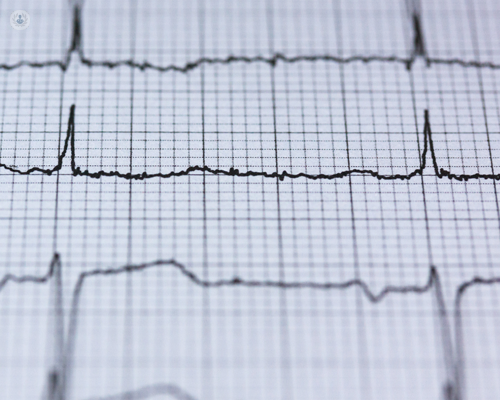

Edited by: Karolyn Judge If you experience a fluttering sensation in the chest, or a racing heartbeat, for example, it could mean you have a cardiac arrhythmia. And in turn, require further analysis by using an implantable loop recorder. Leading cardiologist Dr Jonathan Behar details how this device plays an important role in ensuring experts can make the correct diagnosis and begin the right treatment.
Implantable loop recorders are really clever devices that sit just underneath the skin. They're implanted very easily, within a matter of minutes, using a local anaesthetic procedure. They're pretty small; probably about 4 or 5 centimetres in length, and sit just underneath the skin on the chest wall. They're able to detect abnormalities in the heart rhythm, so, particularly fast heart rhythms or particularly slow ones. Most importantly, we're able to correlate how you, the patient, is feeling at the time of observing what the heart rhythm is doing so that we can understand what your symptoms are due to. As a result of that, we recommend the necessary treatment. Sometimes that treatment might be a catheter ablation procedure for a particularly fast heart rate, and sometimes it might be identification of a slow heart rate that might require a pacemaker procedure. Occasionally, we might pick up an irregular heartbeat like atrial fibrillation, and this might be a really important diagnosis for some patients, as they require blood-thinning medication to prevent stroke. In summary, an implantable loop recorder really has many functions. It's able to detect multiple different heart rhythm abnormalities, and is a very safe and quick procedure performed under local anaesthetic.
This is by definition, an implantable device. It sits just under the skin and is able to detect electrical activity in the heart. Because it's implantable, it's not a wearable device and therefore it stays inside of you for the duration of the battery, which is normally somewhere between three and four years. After the battery runs out, or at a time where you decide with your doctor, you may be able to have it removed as required.
Generally speaking, most people with a loop recorder can continue their normal life. Occasionally, if you're on blood thinners after the procedure there may be a bit more bruising than usual, and this is something to talk to your doctor about before your procedure. Indeed, be cautious after the procedure, but otherwise you can continue with your normal life and normal activities afterwards.
The implantation is relatively straightforward; it involves a local anaesthetic on the chest wall. Implantation of the device really takes a number of minutes. Sometimes we might put a stitch in the skin, or some steri-strips, which are like little plasters, on top of the wound, and a small dressing. It's really, as simple as that.
Within a few minutes, we can implant the loop recorder with minimal discomfort. In terms of the aftercare, generally the wound heals up within a matter of days, usually a week, and then we're able to remotely follow up the electrical rhythms of your heart via the Cloud, via an app, and via the pacemaker clinic.
If you require expert cardiology treatment in London, arrange an appointment with Mr Behar via his Top Doctors profile.

Book online Call to make an appointment
Dr Jonathan Behar is an award winning consultant cardiologist and electrophysiologist with over 15 years of experience based in London. He primarily practises at the renowned One Heart Clinic Marylebone and One Heart Clinic Highgate, in collaboration with Highgate Hospital. He also practises at London Bridge Hospital. Dr Behar sees patients with a range of cardiac complaints including palpitations, dizziness, blackouts, chest pain and breathlessness. He performs catheter ablati.

By Dr Jonathan Behar
Cardiology
Dr Jonathan Behar is an award winning consultant cardiologist and electrophysiologist with over 15 years of experience based in London. He primarily practises at the renowned One Heart Clinic Marylebone and One Heart Clinic Highgate, in collaboration with Highgate Hospital. He also practises at London Bridge Hospital. Dr Behar sees patients with a range of cardiac complaints including palpitations, dizziness, blackouts, chest pain and breathlessness.
He performs catheter ablations for a range of arrhythmias with a particular interest in new technologies for the treatment of atrial fibrillation. He is highly experienced in the implantation of cardiac devices (pacemakers, defibrillators and cardiac resynchronisation therapy) including the latest, miniaturised leadless pacemakers. He also regularly sees patients with a range of general cardiology problems including high blood pressure, high cholesterol and cardiovascular risk factor optimisation.
Dr Behar undertook his inital medical studies (Bachelor of Medicine, Bachelor of Surgery) at the prestigious Royal Free and University College Medical School in 2006. Following this, he pursued a post graduate certificate in internal medicine as part of The Royal College of Physicians and was awarded a PhD in Imaging Sciences and Biomedical Engineering from King’s College London in 2017.
He is devoted to continually improving his skills and has sucessfully completed training in cardiac rhythm management, which he pursued at Barts Heart Centre. He is an International Board of Heart Rhythm Examiners recognised certified cardiac devices specialist and a certified electrophysiology specialist.
Dr Baher is truly invested in medical education. He is an honorary & adjunct senior clinical lecturer at King's College London and previously held the role of honorary clinical lecturer in clinical innovation at Queen Mary University of London. In addition, he was awarded a highly prestigious Health Education England Topol Digital Fellowship in 2022 for his work on digital consent.
He has been nominated for and received numerous awards, including an Excellence in Patient Care Award from The Royal College of Physicians in 2021. He is a member of multiple medical organisations, including The Royal Colleges of Physicians and European Heart Rhythm Association.
Overall assessment of their patients